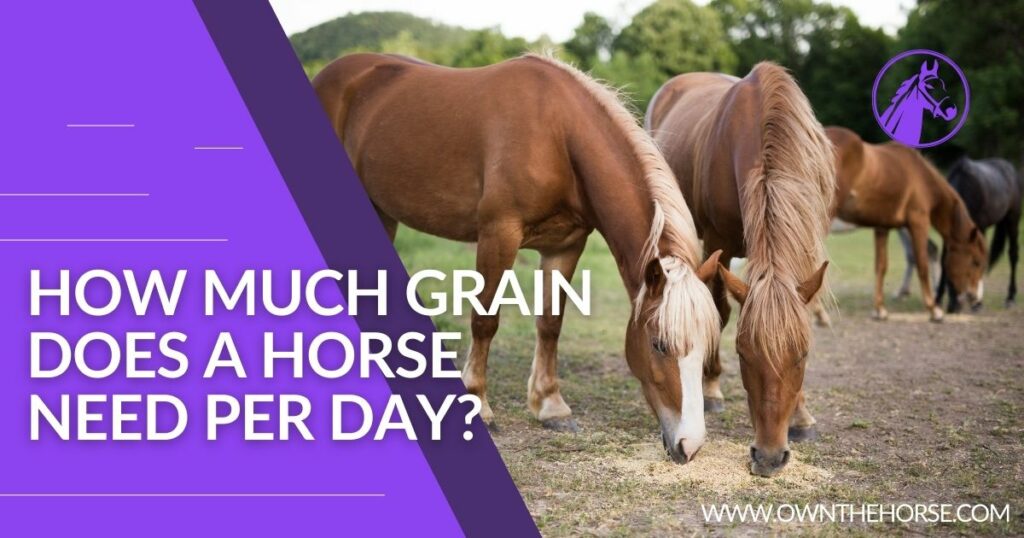As an Amazon Associate we earn from qualifying purchases.
When it comes to the nutritional needs of horses, one of the key components is grain. Grain serves as an important source of energy and essential nutrients for these majestic creatures. As an avid horse owner or enthusiast, understanding the optimal amount of grain a horse needs per day is crucial for their overall well-being. In this comprehensive guide, we will delve into the factors that influence a horse’s grain requirements and provide you with valuable insights to help you make informed decisions.
Short Answer …
S how much grain does a horse need per day? A horse typically needs between 5-15 pounds of grain per day, depending on its size, activity level, and other dietary needs.
The Importance of Proper Nutrition for Horses
Before we delve into the specifics of grain requirements, it is vital to highlight the significance of proper nutrition for horses. Horses, being herbivores, have unique dietary needs that must be met to maintain their health and performance levels. A well-balanced diet ensures optimal growth, development, and overall vitality.
The primary components of a horse’s diet consist of forage, such as hay or pasture, and concentrates, including grains. While forage is the foundation of their diet, providing essential fiber and roughage, grains offer additional nutrients and energy to support their daily activities.
SEE ALSO : Do Horses Eat Meat?
Factors Influencing Grain Requirements
Determining the appropriate amount of grain for a horse requires considering several key factors:
- Workload and Activity Level: The intensity and duration of a horse’s work or exercise greatly impact their energy requirements. Horses engaged in light to moderate activities may require less grain than those involved in intense training or competitive disciplines.
- Age and Growth Stage: Young, growing horses have higher nutritional demands to support their development. As they mature, their grain requirements may change. Additionally, senior horses may require specialized diets due to age-related factors.
- Body Condition: The body condition score of a horse helps assess its overall health and nutritional needs. Horses with low body condition may need increased grain intake to promote weight gain and improve muscle condition.
- Metabolism and Digestive Efficiency: Each horse has a unique metabolism and digestive system. Some horses efficiently utilize nutrients from forage alone, while others may require additional grain to meet their energy demands.
- Breed and Size: Different horse breeds and sizes have varying metabolic rates and energy requirements. Larger breeds or horses with a higher activity level may necessitate more grain to maintain their energy balance.
- Health and Medical Conditions: Certain health conditions, such as insulin resistance or metabolic disorders, may warrant dietary modifications, including grain restrictions or alternative feed options. Consulting with a veterinarian is crucial in such cases.
Calculating Grain Requirements
To determine the appropriate amount of grain to feed your horse, it is recommended to consult with an equine nutritionist or veterinarian. They can provide personalized advice based on your horse’s specific needs. However, here is a general guideline to get you started:
- Weighing and Assessing Forage: Begin by weighing the amount of forage your horse consumes daily. Forage should make up the majority of their diet, typically around 1.5% to 2.5% of their body weight.
- Evaluating Body Condition: Assess your horse’s body condition score to determine if any adjustments are necessary. A score between 4 and 6 on a 9-point scale is generally considered ideal.
- Understanding Energy Requirements: Consider your horse’s activity level and workload. Light work may require 0.3% to 0.5% of their body weight in grain, while moderate to heavy work may necessitate 0.5% to 0.8%.
- Splitting Feedings: Dividing the grain into multiple small meals throughout the day helps mimic the natural grazing pattern of horses and promotes efficient digestion.
- Monitor and Adjust: Monitor your horse’s condition and performance regularly. If you notice any changes in weight, body condition, or overall well-being, it may be necessary to make adjustments to their grain intake. Remember that each horse is unique, and their nutritional needs can vary, so it’s essential to observe and adapt accordingly.
Choosing the Right Grain
Not all grains are created equal, and selecting the appropriate grain for your horse is vital to ensure their nutritional requirements are met. Here are some common grains used in horse feed:
- Oats: Oats are a popular choice for horses due to their high fiber content and moderate energy levels. They are easily digestible and provide a steady release of energy, making them suitable for horses in light to moderate work.
- Barley: Barley is another grain option commonly used in horse feeds. It provides more energy compared to oats but should be used with caution as excessive amounts may cause digestive upset. Barley is often included in feed mixes for horses in moderate to heavy work.
- Corn: Corn is a high-energy grain that can be beneficial for horses with increased energy demands, such as those involved in intense training or competitions. However, corn should be processed or cracked before feeding to enhance digestibility.
- Wheat: Wheat is not as commonly used in horse feeds as oats, barley, or corn. It is higher in protein but lower in fiber, so it should be fed in moderation and balanced with other grains and forage sources.
When selecting a commercial horse feed, it’s crucial to carefully read the labels and choose a product that aligns with your horse’s specific needs. Look for feeds that are specifically formulated for your horse’s age, activity level, and any specific health concerns they may have.
To buy top quality Grain near you follow this link.
Considerations and Best Practices
While grain is an essential component of a horse’s diet, it should be used judiciously and in conjunction with other feed sources. Here are a few considerations and best practices to keep in mind:
- Forage First: Forage, such as high-quality hay or pasture, should be the foundation of your horse’s diet. It provides essential fiber, promotes healthy digestion, and helps prevent issues like colic and boredom.
- Introduce Changes Gradually: When making any adjustments to your horse’s diet, including changes in grain type or amount, it’s important to introduce them gradually over several days. Abrupt dietary changes can disrupt the horse’s digestive system and lead to issues like colic or diarrhea.
- Regular Exercise and Turnout: Alongside a balanced diet, horses require regular exercise and ample turnout time to maintain their overall well-being. Exercise helps stimulate digestion, supports muscle development, and promotes mental stimulation.
- Fresh Water Access: Always ensure your horse has access to clean, fresh water at all times. Proper hydration is crucial for overall health and aids in digestion.
- Consult with Professionals: If you have any concerns or questions regarding your horse’s nutrition, it’s best to consult with equine nutritionists, veterinarians, or experienced professionals who can provide tailored advice based on your horse’s individual needs.
In conclusion, understanding and meeting a horse’s grain requirements is essential for their overall health, performance, and well-being. Factors such as workload, age, body condition, and individual metabolism influence the amount of grain a horse needs per day. By considering these factors, consulting professionals, and implementing best practices, you can ensure that your horse receives the optimal grain intake to thrive and excel.
Amazon and the Amazon logo are trademarks of Amazon.com, Inc, or its affiliates.

Hey there, I’m Jasmine! I’m a total horse fanatic and have been working with these amazing animals for as long as I can remember. I’m passionate about sharing my love for horses with others and helping them learn more about these majestic creatures. As a professional horse trainer and riding instructor, I’ve developed a deep understanding of equine science and am committed to the welfare of horses. That’s why I founded OwnTheHorse.com, a blog where I share my knowledge and insights with fellow horse enthusiasts. I love connecting with my readers and building a friendly community of horse lovers. Whether you’re a seasoned equestrian or just starting out, I’m here to help and inspire you. Above all, I’m a friendly and compassionate person who truly cares about the well-being of horses and their human companions.

